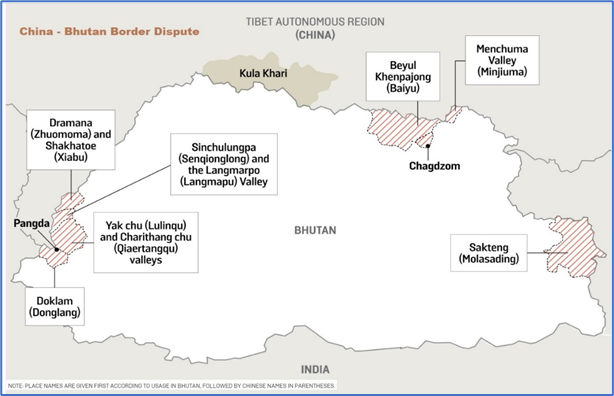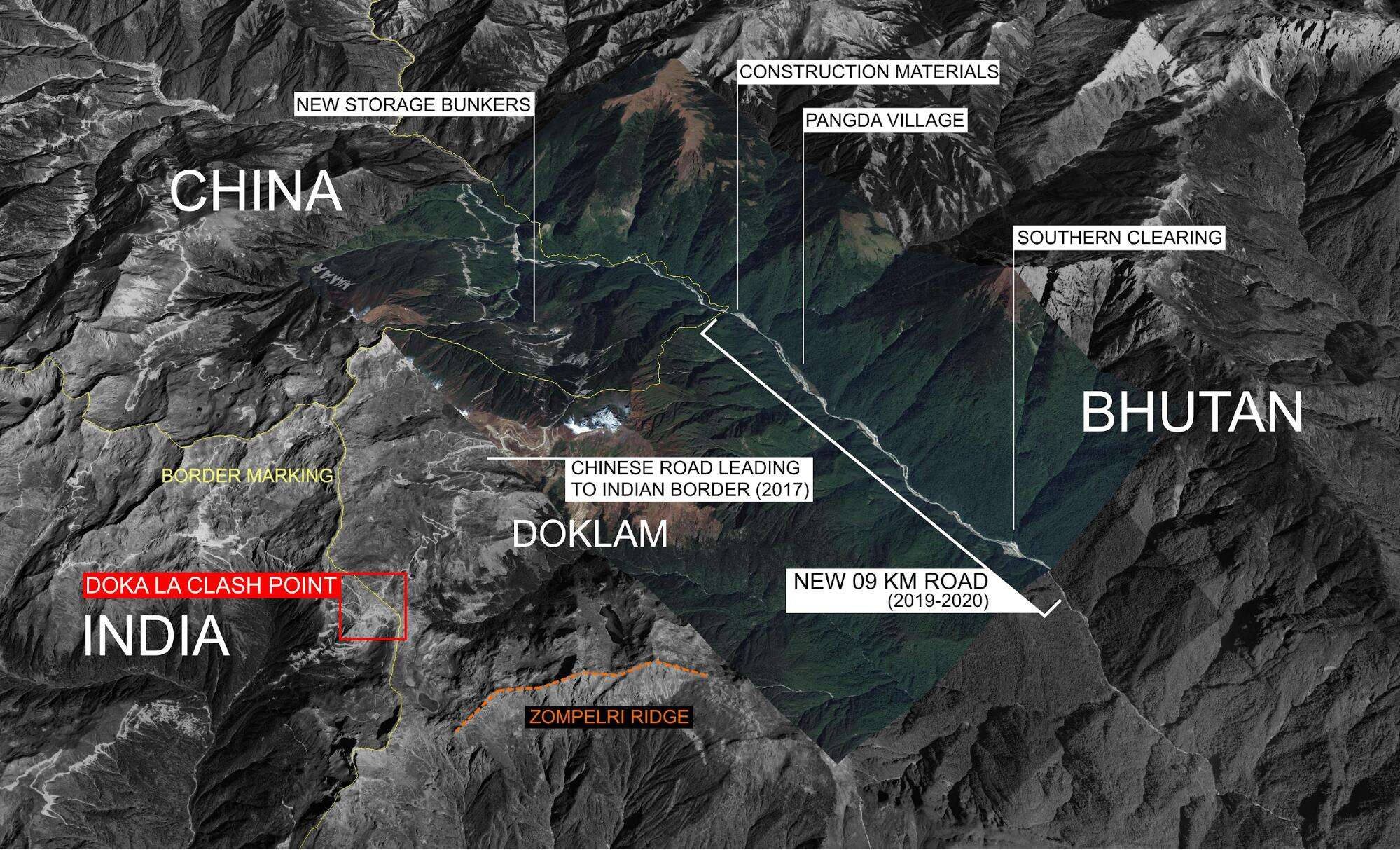International Relations
China and Bhutan Meet to Delimit Boundary
- 29 Aug 2023
- 9 min read
For Prelims: India-Bhutan Relations, Treaty of Friendship in 1949
For Mains: Challenges in India-Bhutan Relations, Chinese Challenge in the Region
Why in News?
Recently, China and Bhutan held the 13th Expert Group Meeting (EGM) in Beijing, focusing on boundary delimitation. The meeting marked the establishment of a Joint Technical Team on the Delimitation of the China-Bhutan Boundary.
- As both nations aim to expedite boundary resolution, this move holds implications for the broader regional context, including India.
What are the Key Highlights of the 13th Expert Group Meeting Meeting?
- Both nations expressed their commitment to expedite efforts towards achieving a resolution on the disputed boundary.
- Plans were laid out for the upcoming 14th round of boundary talks to maintain the encouraging pace.
- The meeting addressed the implementation of the Three-Step Road Map, reflecting the commitment to follow the outlined strategy for expediting boundary negotiations.
How Recent Developments in China-Bhutan Relations Concerning India?
- Recent developments of China and Bhutan could affect India’s strategic interests, especially in the Doklam tri-junction, where India, Bhutan, and China meet.
- China has also revived its claim to the eastern region of Bhutan, known as Sakteng (Wildlife Sanctuary), which borders the Indian state of Arunachal Pradesh.
- China considers Arunachal Pradesh as part of its territory and calls it “South Tibet”. China’s claim to Sakteng could be seen as a pressure tactic to force Bhutan to accept its terms on the boundary issue, as well as to challenge India’s sovereignty over Arunachal Pradesh.
- Bhutan is one of India's closest allies in the region, and India has long provided economic and military support to Bhutan. However, in recent years, China has been increasing its economic and diplomatic ties with Bhutan, which could potentially weaken India's influence in the region.
How have been India’s Relations with Bhutan?
- Historical and Cultural Ties:
- India and Bhutan share a common cultural heritage, rooted in Buddhism, Hinduism, and other traditions.
- A number of Bhutanese pilgrims travel to Bodh Gaya, Rajgir, Nalanda, Sikkim, Udayagiri, and other Buddhist sites in India.
- Bhutan was one of the first countries to recognize India’s sovereignty and independence in 1947 and has supported its development and modernization ever since.
- Strategic and Security Cooperation
- India and Bhutan signed a Treaty of Friendship in 1949, which was revised in 2007, to establish peace and non-interference in each other’s internal affairs.
- India has provided Bhutan with assistance in areas such as defence, infrastructure, and communication, which has helped to maintain Bhutan's sovereignty and territorial integrity.
- In 2017, during the Doklam standoff between India and China, Bhutan played a crucial role in allowing Indian troops to enter its territory to resist Chinese incursions.
- Economic and Development Partnership:
- The India-Bhutan Agreement on Trade, Commerce, and Transit (signed in 1972 and revised in 2016) establishes a free trade regime between the two countries.
- India is Bhutan’s largest trading partner. India also provides economic aid and assistance to Bhutan’s socio-economic development, especially in the sectors of agriculture, irrigation, infrastructure, energy, health, education, and culture.
- India’s top exports to Bhutan are petrol & diesel, passenger cars, rice, wood charcoal, cellphones, soya-bean oil, excavators, electric generators and motors, parts for turbines, and transport vehicles.
- India’s top imports from Bhutan are electricity, betel nut, oranges, semi-finished products of iron or non-alloy steel, boulders, etc.
- India is the leading source of investments in Bhutan, comprising 50% of the country’s total FDI.
- Hydropower Cooperation:
- This hydropower cooperation comes under the 2006 Agreement on Cooperation in Hydropower.
- India has agreed to assist Bhutan in the development of a minimum of 10,000 MW of hydropower and import of surplus electricity from the same by 2020.
- Four hydroelectric projects (HEPs)- Chhukha, Kurichu, Tala, and Mangdechhu totaling 2136 MW are already operational in Bhutan and are supplying electricity to India.
- Two HEPs Punatsangchhu-I and, Punatsangchhu-II in Inter-Governmental mode are under various stages of implementation
- This hydropower cooperation comes under the 2006 Agreement on Cooperation in Hydropower.
- Multilateral Partnership:
- Both of them share multilateral forums such as South Asian Association for Regional Cooperation (SAARC), BBIN (Bangladesh, Bhutan, India, and Nepal), BIMSTEC (Bay of Bengal Initiative for Multi Sectoral Technical and Economic Cooperation) etc.
- People-to-People Contacts:
- About 50,000 Indian citizens are working in Bhutan, mainly in the construction sector, education and technical consultants involved in infrastructure projects.
- India is the most popular educational destination for Bhutanese students.
- India and Bhutan also exchange cultural delegations, artists, scholars, exhibitions, festivals, etc. to promote cultural understanding and appreciation.
What are the Challenges in the India-Bhutan Relations?
- China's increased presence in Bhutan, especially along the disputed border, raises alarms in India due to strategic implications.
- India and Bhutan share a 699 km border, mostly peaceful, but recent Chinese border incursions, like the 2017 Doklam standoff, have caused tensions among India, China, and Bhutan, potentially affecting India-Bhutan relations.
- Bhutan's economy relies heavily on hydropower, with India playing a crucial role in its development. Concerns in Bhutan about terms of some projects favoring India have led to public opposition.
- India is Bhutan’s largest trading partner and source of tourists. However, there have been some frictions over trade and tourism policies between the two countries.
- For instance, Bhutan has expressed concerns over the environmental impact of trade and tourism on its fragile ecology and culture and proposed to levy entry charges on Indian tourists.
- According to All India Surveys of Higher Education (AISHE), the number of Bhutanese students receiving tertiary education in India declined to just 3.8% of all international students from 7% a decade ago.
Way Forward
- Collaborating on regional multilateral platforms to promote stability and shared interests.
- Encouraging transparent communication between India, Bhutan, and China to mitigate border tensions.
- Addressing concerns over hydropower projects through dialogue and fair terms to benefit both nations.
- India and Bhutan could establish a joint committee to collaboratively formulate sustainable policies that balance economic interests with ecological and cultural preservation.
- India can help Bhutan in the areas of education and skill development by providing scholarships to Bhutanese students and training programs to enhance the skills of Bhutanese professionals.
UPSC Civil Services Examination, Previous Year Question (PYQ)
Mains
Q. Border management is a complex task due to difficult terrain and hostile relations with some countries. Elucidate the challenges and strategies for effective border management. (2016).









